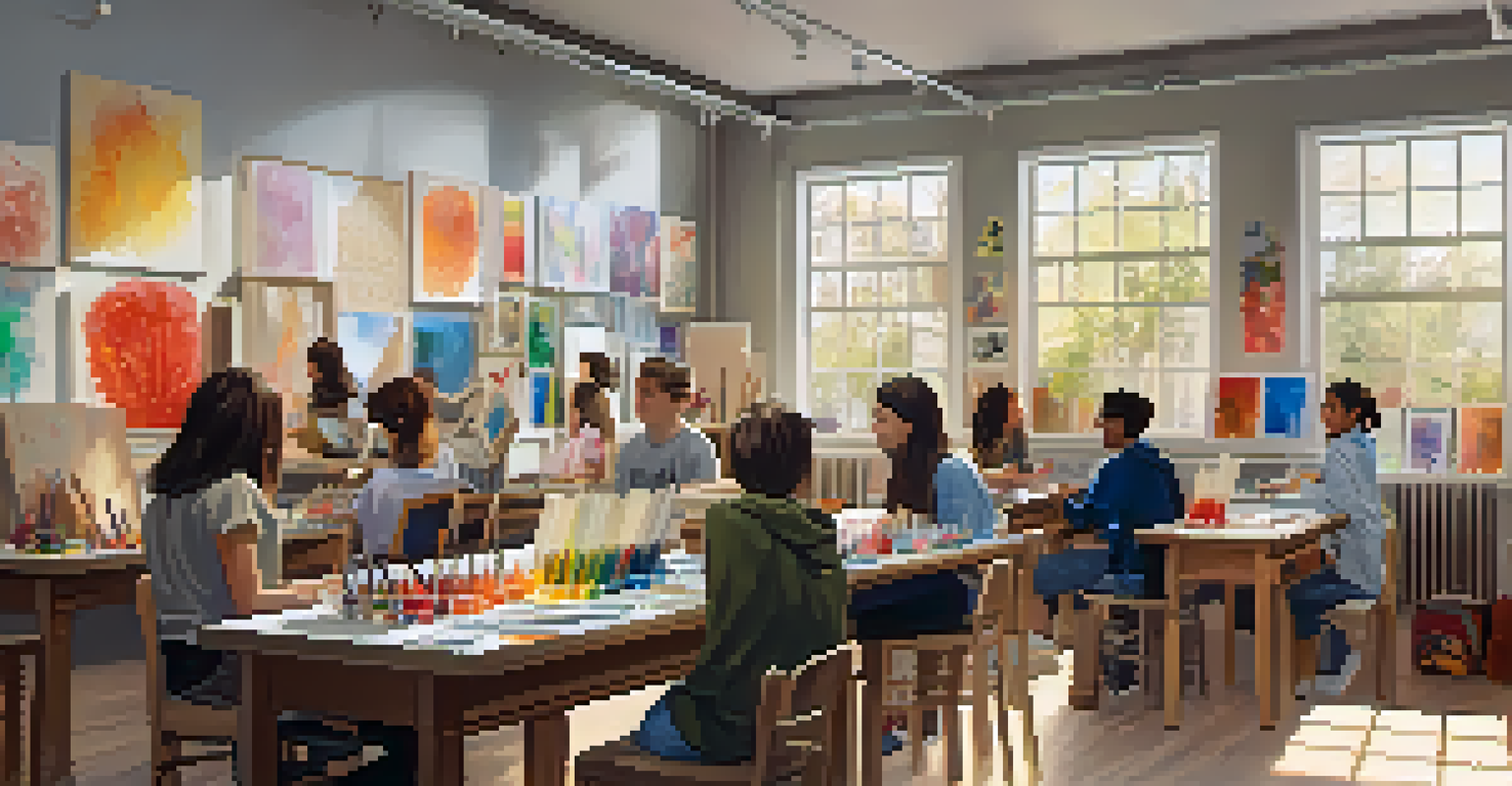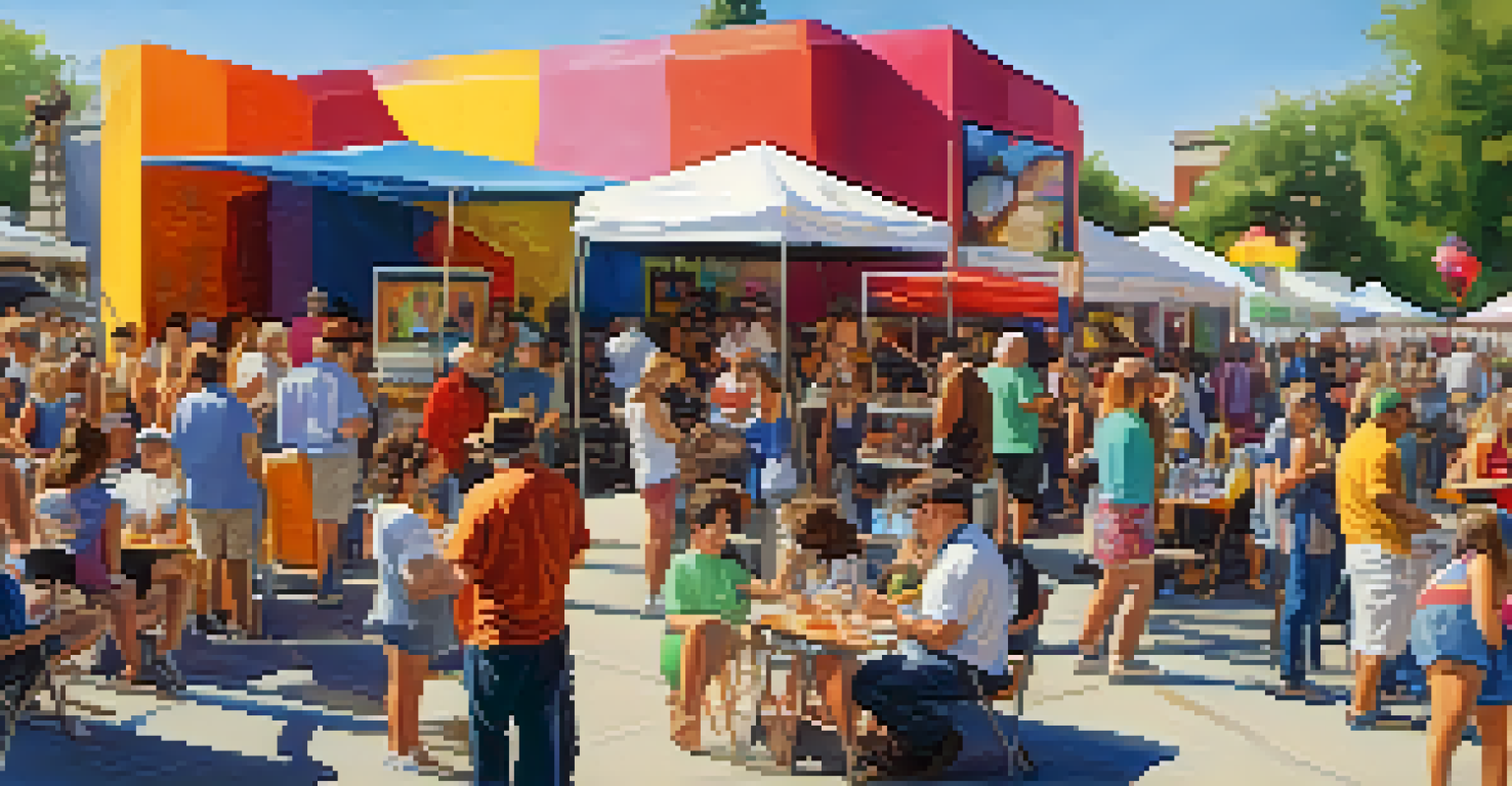Art Education Programs: Nurturing Community Connections

Understanding the Role of Art Education in Communities
Art education programs serve as vital hubs for creativity and expression within communities. They encourage individuals to explore their artistic talents while fostering a sense of belonging. By providing a platform for diverse voices, these programs help bridge gaps between different cultural and socioeconomic backgrounds.
Art is not what you see, but what you make others see.
Moreover, art education isn't just about creating art; it's about building connections. Participants often form relationships that extend beyond the classroom, leading to collaborative projects and community events. This sense of unity enhances social cohesion, making communities more resilient.
When people engage in shared artistic endeavors, they cultivate empathy and understanding. Art becomes a universal language, allowing individuals to communicate their experiences and perspectives. Thus, art education programs play a crucial role in fostering inclusive communities.
How Art Programs Promote Cultural Awareness
Art education programs often showcase a variety of cultural traditions, allowing participants to learn about and appreciate different heritages. Through workshops, exhibitions, and performances, individuals experience art forms that may be unfamiliar to them. This exposure not only enriches their artistic skills but also broadens their worldview.

For example, a community center may host a mural project that incorporates styles from various cultures, turning the final piece into a tapestry of community history. This collective creation not only beautifies the neighborhood but also sparks conversations about cultural identities and stories. Participants become storytellers, sharing their backgrounds through their art.
Art Education Builds Community Bonds
Art education programs foster connections among individuals, creating unity and resilience within communities.
Ultimately, these programs encourage respect for diversity and foster a sense of pride in cultural heritage. As participants learn from one another, they develop a deeper appreciation for the richness that different cultures bring to their community.
Building Lifelong Connections Through Collaboration
Collaboration is a cornerstone of art education programs, where participants often work together on projects. This teamwork nurtures communication skills and teaches the value of diverse perspectives. When individuals collaborate, they learn to appreciate different approaches, enhancing their creative processes.
Every artist was first an amateur.
An excellent example of this collaboration can be seen in community theater productions, where people of all ages come together to create a performance. From acting to set design, each participant contributes their unique skills, fostering a strong sense of camaraderie. These shared experiences often lead to lasting friendships and a stronger community bond.
By participating in collaborative projects, individuals not only develop their artistic talents but also build networks that extend beyond art. These connections can lead to new opportunities, partnerships, and a stronger support system within the community.
Empowering Youth Through Artistic Expression
Art education programs play a crucial role in empowering youth by giving them a voice. Through creative expression, young individuals can explore their emotions, experiences, and aspirations. This empowerment is essential for personal growth and helps build confidence.
For instance, a local art program might host workshops where teens create pieces that address social issues they care about. By highlighting their thoughts and feelings through art, they engage in meaningful conversations about their community. This not only raises awareness but also inspires change.
Cultural Awareness Through Art
These programs promote respect for diversity by showcasing various cultural traditions and encouraging dialogue.
Furthermore, these programs often provide mentorship opportunities, connecting youth with experienced artists. This guidance helps nurture their talents and encourages them to pursue careers in the arts, ultimately contributing to a vibrant and diverse community.
Enhancing Mental Health Through Artistic Activities
Engaging in art can have profound effects on mental health and well-being. Art education programs provide a therapeutic outlet for individuals to express their feelings and cope with stress. Creative activities have been shown to reduce anxiety and depression, making them essential for community health.
For example, community art classes often include mindfulness techniques, allowing participants to focus on the process of creation rather than the final product. This mindful approach can help individuals feel more present and connected to themselves and others. As they create, they also find solace and joy in the act of making.
Ultimately, by prioritizing mental health through art, these programs create healthier communities. Participants leave feeling rejuvenated and more connected, which enhances overall community well-being.
Fostering Economic Growth Through Art Programs
Art education programs can also contribute to local economic development. By attracting participants and visitors, these programs stimulate business and tourism in the community. Art events, exhibitions, and classes can draw crowds, leading to increased sales for local businesses.
Art initiatives often lead to the creation of public art and beautification projects, which enhance the community's appeal. A vibrant arts scene can turn a neighborhood into a destination, encouraging investment and development. This, in turn, creates jobs and opportunities for local artists.
Empowering Youth via Artistic Expression
Art education empowers young people to explore their emotions and aspirations, enhancing their personal growth and confidence.
Moreover, when communities support local artists through these programs, they empower them to thrive. This supportive ecosystem fosters innovation and creativity, making the community more dynamic and economically resilient.
The Future of Art Education Programs in Communities
As we look to the future, the importance of art education programs in communities continues to grow. With advancements in technology and new mediums emerging, these programs can adapt and expand, reaching even broader audiences. Online workshops and virtual exhibits can connect people from different locations, enriching the community experience.
Moreover, there's a growing recognition of the role of arts in education and community development. Schools and organizations are increasingly collaborating to incorporate art into curricula and community initiatives. This holistic approach ensures that art education remains a priority.

Ultimately, as art education programs evolve, they will continue to nurture community connections and foster creativity. By investing in these initiatives, we pave the way for vibrant, inclusive, and resilient communities for generations to come.